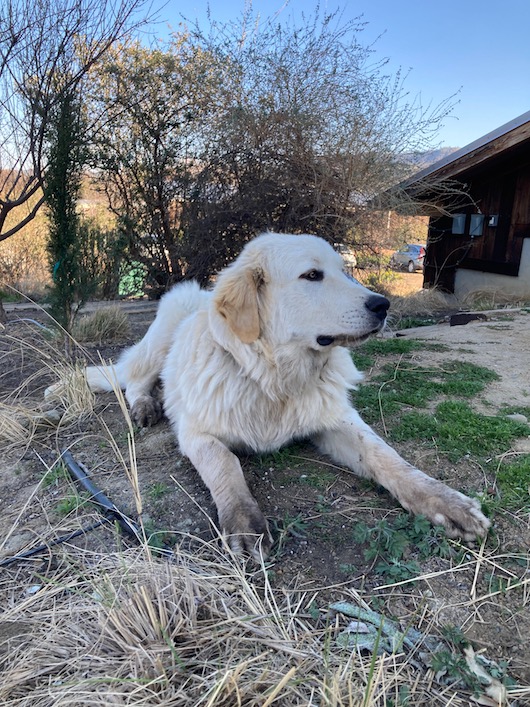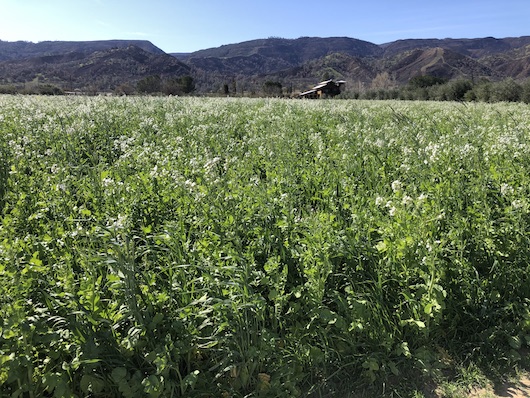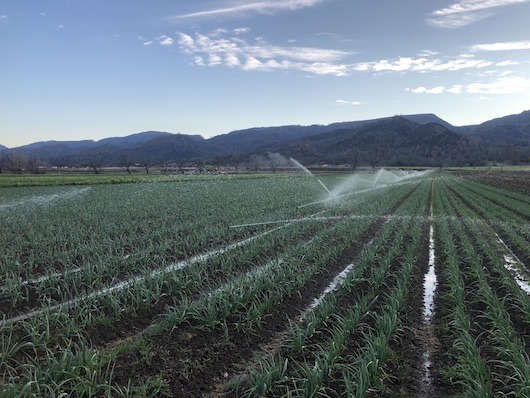
Griffin the Guard Dog —
What a wild turbulent week we have had here on this Full Moon end of February week here at the farm. Warm sunny days were followed by howling north winds and then more dry warm sunny days…. The old comment goes that we had 4 inches of rain this year and 14 inches of drying wind to soak it up. The winds have been powerful and persistent, the days far too warm for February and the worries about a drought have us making plans for a dry year.
Farming in a drought or in dry weather is deceptively easy- we are busy working down cover crops and readying fields for spring crops. The soil is moist and mellow under the cover of oats, vetch, clovers, bell beans, tillage radish, peas, rye grass, phacelia and an assortment of weeds that join the mix. We are choosing to create complex plant mixes in our cover crop plantings. There is growing evidence that the mix of more than 8 species enhances the drought tolerance of the whole. Although we have had but about 4.5 inches of rain this year, the multi-species fields are lush and thriving. Other farmers across the country are also experimenting with diverse seed mixes and observing the same results.

Mixed species cover crop. The white flowers are the tillage radishes.
It appears that soil microbiology likes diversity in the shared environment of a root zone. Multiple species above ground collect sunlight and generate unique contributions of sugars and root exudates that feed the bacterial and fungal life below ground. The diverse diet of these sugars creates a more dynamic whole and fosters populations of bacteria that appear to be community oriented (called oliotrophic bacteria). These populations generally differ from the bacteria in tilled fields (copiotrophic bacteria). The former appear to work in concert with other microbial populations and have a long term function of community food sourcing for plant health, and the latter feed on the organic matter that is tilled into the soil–a fast growing opportunistic community.
The fungal population that surrounds each root of a plant acts as a network that not only forages for food to nourish the plant, but also has a function in storing and releasing moisture from rain or dew absorbed from the plant leaf surface and transferred into the soil. Fungi then take the weak acids that the above ground plant generates and exudes into the soil and uses these acids to break down soil particles and liberate nutrients that are then gathered to feed the above ground portion of the plant. Diversity of species amplifies the functioning of the whole. Dr Christine Jones, an Australian microbiologist calls this Quorum Sensing. The key to this energy and carbon contribution rests in those associations of living plants gathering sunlight and through photosynthesis making food for the below ground community.
As farmers, we have the unique opportunity to interact with and modify this system and accelerate the functioning of these related parts through our management. There is growing scientific evidence and reports from farmers in the field that the health of a whole system can be enhanced not just by pulling more carbon into the soil with a concerted effort at keeping fields green and thus harvesting more sunlight annually, but also through water management, mindful tillage or no tillage, adding animals to the system and keeping soil covered. We are adapting and changing our farm strategies to adjust to many variables in growing your food and making it as rich and healthy as possible.
We have about 12 acres of spring potatoes in the ground, asparagus is now just beginning, and new plantings of flowers are continuing. Andrew has been planting greens and spring crops as we ready ourselves to begin summer plantings. Aphid numbers are rising on some of the crops necessitating releases of beneficial insects. We are in the midst of fruit and nut bloom – send any of your extra bees our way.
The full moon brings out crying, whooping and yipping coyotes raising Cain in the fields around the farm. I am sure that they are watching our lambs at night growing fatter across the thin strands of electric fence and lamenting their yearning for a tender lamb chop. They also circle the fences constructed to guard the laying hens on the farm looking for an opportunity to visit and hoping to have a quick bite of chicken.
We’ve not seen tracks of the mountain lion lately and feel fortunate for that. Griffin, an adolescent Great Pyrenees, is a new addition to the farm menagerie. He will be tasked with protecting the perimeter of the farm. The breed is known to roam the edges of a farm at night to persuade invading critters to look elsewhere. Many farms use guard dogs and guard animals like Llamas to bond with a group of sheep, live in their midst and chase away any potential predators.
Rye and Becca are the chicken keepers here. They order waves of 300 or so chicks to be raised and nurtured to become our laying hens. After three months, the chicks become pullets, (young hens) starting their laying career here. Earlier this month, a sneaky skunk found its way into a henhouse, probably evading the electric fence and getting in before the automatic doors closed at sunset. That skunk was not content to grab a bite of only one new hen, but killed 40 in the coop.
It was a relentless, sleepless night for a skunk – what a stinker – and it was a heartbreaking morning when the birds were discovered. We trapped and eliminated the skunk that next night as he returned to express his ruthless skunk nature. Things have settled since, but the wariness remains and the lessons of keeping creatures here are clearly about having a strategy, losing some fights and trying new things to protect our wards.
But back to dry, cloudless skies. First, a confession. I am not a total skeptic about our ability to bring on rain. I am talking about rain dances, welcoming rain, keeping things green to create ionizing particles that create precipitation, or the intention to give thanks for the generous gift of life that moisturizing rain brings. Maybe it is circumstance or coincidence, but we have had moments where I have danced for rain: here at the farm; after a Hoes Down; during a Hoes Down; after an Eco Farm conference; or with hooting children on the front lawn here at the farm where the dance and the intention have broken a spell of dry. In all of these instances, rain came – not a predicted rain, but in a couple of those cases unpredicted clouds came and rain followed.

Irrigating in February
I realize this confession borders on being a religious heretic, scientific denier, or profferer of ridiculous nonsense. But like many things we see here on the farm, we cannot totally control the dynamic with which we participate. It may lead to less than scientific thoughts but the idea flirts with both humility and empowerment. We all create the world we live in and it is our good-hearted intention that helps to shape our realities. There is energy found in thoughts of peace and creation, and new realizations when one embraces mystery dancing on the edges with science.
We have more power in regard to creation than we know. It is how we see our relationship to a healthy whole that shapes our realization of that whole. We can learn a great deal when we imagine other possibilities. Use the example of soil and its underappreciated nature as a whole organism rather than a collection of nutrients, or sand silt and clay. We are beginning to see Soil as a living dynamic whole that can’t be taken completely apart and studied because parts of it only exist in relation to other parts. Split it up in a lab and the parts in relationship disappear.
Can it be that a farmer or a group associated with land, food and place can become an intimate part of that place and responsible for its keeping? Can it be that we are all under-appreciating our relationship to and responsibility for a healthy whole? Can we bring on rain with our dance, our wholehearted welcoming, our willingness to drop any notion of inconvenience when rain offers to build and come?
My Daughter, Hallie was born in a wild storm in March 1986. As we waited for the midwives to find their way to the farm through flooded roads, we marveled at the lifegiving rain – looking out our window at the sweep of green fields being pelted by a fierce storm. We looked up the driveway and not ½ hour after the midwives arrived, she was born in a woosh of water and brought into this world. She used to dance with me in calling the rain. We would shout to the clouds: Come on rain! And dance and hoot: she would dance by herself outside and more often than not rain would fall. I always felt she had a special gift with regard to rain. Yes coincidence, yes impossible, yes humbling and mysterious.
It is silly to think of such things. Have a great week and welcome the rain in with us. Dance a bit and marvel in both mystery and endless possibilities.
— Paul Muller

Almost ready for supper – By Maria Grazia
